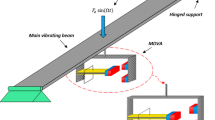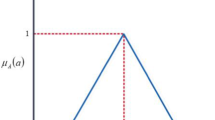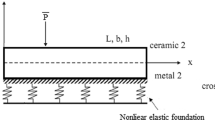Abstract
This study investigates the transverse free vibration of general type of non-uniform beams with general non-classical boundary conditions at both ends based on the exploitation of Cauchy’s formula for iterated integrals. A review of related sources shows that despite of many studies and various methods used to investigate the transverse vibrations of non-uniform and inhomogeneous beams, no solutions applicable for free vibrations in such beams with general boundary conditions were proposed. In this article, Hamilton's principle is utilized to derive the partial differential equation governing the transverse vibration of the inhomogeneous non-uniform beam as well as the general corresponding boundary conditions. The effect of the boundary conditions, mass object, eccentricity and aspect ratios on the natural dimensionless transverse frequencies has been analyzed. The flowcharts of analyzing frequency parameters and mode shapes are also given in details to state the proposed method visually. The performance of the proposed method has been verified through numerical examples available in the published literature. All results exhibit that the proposed method is capable to analyze the free vibration of general type of non-uniform and axially FG Euler–Bernoulli beams with various general boundary conditions. Utilizing the proposed method and their related equations, it is possible to analyze the vibrations of different types of homogeneous uniform, homogeneous non-uniform, functionally graded uniform, and functionally graded non-uniform beams.

















Similar content being viewed by others
References
Lindberg GM (1963) Vibration of Non uniform Beams. Aeronautical Quart, pp 387–395.
Gaines JH, Voltera E (1965) Transverse vibrations of Cantilever Bars of variable cross section. J Acoust Soc Am 39(4):674–679
Downs B (1977) Transverse vibrations of cantilever beams having unequal breadth and depth tapers. J Appl Mech, pp 737–742.
Naguleswaran S (1992) Vibration of an Euler-Bernoulli beam of constant depth and with linearly varying breadth. J Sound Vib 153(3):509–522
Naguleswaran S (1994) A direct solution for the transverse vibration of Euler-Bernoulli wedge and cone beam. J Sound Vib 172(3):289–304
Laura PAA, Gutierrezi RH, Rossi RE (1996) Free vibrations of beams of bilinearly varying thickness. Ocean Eng 23(1):1–6
Zhou D, Cheung YK (2000) The free vibration of a type of tapered beams. Comput Methods Appl Mech Eng 188:203–219
Mehmet CE, Metin A, Vedat T (2007) Vibration of a variable cross-section beam. Mech Res Commun 34:78–84
Abdolghani SM, Ewis KM, Mahmoud AA (2015) Vibration of a circular beam with variable cross sections using differential transformation method. Beni Suef University J Basic Appl Sci 4:185–191
Lee JW, Lee JY (2016) Free vibration analysis using the transfer matrix method on a tapered beam. Comput Struct 164:75–82
Kim T, Lee B, Lee U (2019) State vector equation method for the frequency domain spectral element modelling of non-uniform one-dimensional structures. Int J Mech Sci 157–158:75–86
Rosa MAD, Auciello NM (1996) Free vibrations of tapered beams with flexible ends. Comput Struct 60(2):197–202
Auciello NM (1996) Transverse vibrations of a linearly tapered cantilever beam with tip mass of rotatory inertia and eccentricity. J Sound Vib 194(1):25–34
Lai HY, Chen CK, Hsu JC (2008) Free vibration of non-uniform Euler-Bernoulli Beams by the Adomian modified decomposition method. Comp Model Eng Sci 34:187–113
Celik I (2018) Free vibration of non-uniform Euler-Bernoulli beam under various supporting conditions using Chebyshev Wavelet Collocation Method. Appl Math Model 54:268–280
Ghannadiasl A, Zamiri A, Borhanifar A (2020) Free vibrations of non-uniform beams on a non-uniform Winkler foundation using the Laguerre Collocation Method. J Braz Soc Mech Sci Eng 42(242):1–12
Datta AK, Sil SN (1996) An analysis of free undamped vibration of beams of varying cross-section. Comput Struct 59(3):479–483
Huang Y, Li XF (2010) A new approach for free vibration of axially functionally graded beams with non-uniform cross-section. J Sound Vib 329:2291–2303
Liu P, Lin K, Liu H, Qin R (2016) Free transverse vibration analysis of axially functionally graded tapered Euler-Bernoulli beams through Spline Finite Point Method. Shock Vib 5891030:1–23
Zhao Y, Huang Y, Guo M (2017) A novel approach for free vibration of axially functionally graded beams with non-uniform cross-section based on Chebyshev polynomials theory. Compos Struct, pp 277–284.
Cao D, Cao Y, Wang J, Yao M, Zhang W (2019) Analytical analysis of free vibration of non-uniform and homogenous beams: asymptotic perturbation approach. Appl Math Model 65:526–534
Sahu RP, Sutar MK, Pattnaik S (2022) A generalized finite element approach towards the free vibration analysis of non-uniform axially functionally graded beam. Sci Iran 29(2):556–571
Hein H, Feklistova L (2011) Free vibrations of non-uniform and axially functionally graded beams using Haar Wavelets. Eng Struct 33:3696–3701
Sari MS, Al-Dahidi S (2020) Vibration characteristic of multiple functionally graded non uniform beams. J Vib Control 10:2205–2218
Wu HL, Yang J, Kitipornchai S (2016) Nonlinear vibration of functionally graded carbon nanotube-reinforced composite beams with geometric imperfections. Compos B Eng 90:86–96
Wu HL, Li Y, Li L, Kitipornchai S, Wang L, Yang J (2022) Free vibration analysis of functionally graded graphene nanocomposite beams partially in contact with fluid. Compos Struct 291:115609
Song M, Gong Y, Yang J, Zhu W, Kitipornchai S (2020) Nonlinear free vibration of cracked functionally graded graphene platelet reinforced nanocomposite beams in thermal environments. J Sound Vib 468:115115
Song M, Gong Y, Yang J, Zhu W, Kitipornchai S (2019) Free vibration and buckling analyses of edge-cracked functionally graded multilayer graphene nanoplatelet-reinforced composite beams resting on an elastic foundation. J Sound Vib 458:89–108
Song M, Zhou L, Karunasena W, Yang J, Kitipornchai S (2022) Nonlinear dynamic instability of edge-cracked functionally graded graphene-reinforced composite beams. Nonlinear Dyn 109(4):2423–2441
Rao SS (2007) Vibration of continuous systems. Wiley, New Jersey, p 318
Author information
Authors and Affiliations
Corresponding author
Additional information
Technical Editor: Aurelio Araujo.
Publisher's Note
Springer Nature remains neutral with regard to jurisdictional claims in published maps and institutional affiliations.
Appendices
Appendix A
Components of the \(a\) matrix,\(a_{ij}\) \(\left( {i = 1 - 4, j = 1 - 4} \right)\) in Eq. (19)
The column vector \(b,\) \(b_{i} \left( {i = 1 - 4} \right)\) in Eq. (19)
Solution to the unknowns \(C_{i} \left( {i = 1 - 4} \right)\) utilizing Cramer’s rule
where coefficients \(A_{1}\) to \(A_{8}\) and \(\zeta\) are given by Eqs. (A.7) to (A.11), respectively.
and
Appendix B
See Table 23
Rights and permissions
Springer Nature or its licensor (e.g. a society or other partner) holds exclusive rights to this article under a publishing agreement with the author(s) or other rightsholder(s); author self-archiving of the accepted manuscript version of this article is solely governed by the terms of such publishing agreement and applicable law.
About this article
Cite this article
Hosseini-Hashemi, K., Talebitooti, R., Hosseini-Hashemi, S. et al. A unique and comprehensive approach to investigate the transverse free vibration of non-uniform and functionally graded Euler–Bernoulli beams. J Braz. Soc. Mech. Sci. Eng. 45, 551 (2023). https://doi.org/10.1007/s40430-023-04469-3
Received:
Accepted:
Published:
DOI: https://doi.org/10.1007/s40430-023-04469-3




